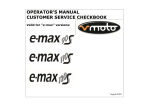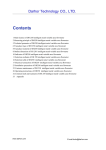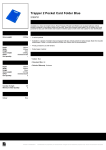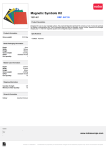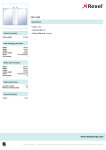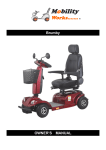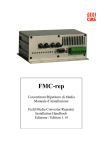Download E-max 110 S Operator`s manual
Transcript
Valid for “e-max” versions: Status as of January 2008 1 English OPERATOR’S MANUAL CUSTOMER SERVICE CHECKBOOK Dear e-max riders, We are pleased that you have chosen one of our brand name vehicles and we welcome you warmly into the large group of e-max riders. This handbook contains tips about correct handling, inspections and service intervals for your e-max scooter. For your safety and in order to guarantee comfortable riding, we recommend that you carefully read this manual before using your vehicle. For problem free operation and maintaining the value of the vehicle ensure professional servicing, following all the established maintenance and driving tips in this handbook as well as having all servicing carried out by an authorised e-max specialised dealer at the correct time intervals as specified in this manual. We wish you an enjoyable and safe riding experience! 2 1. Safety tips Before use: Check the scooter to make sure that: • the cord from the charger is removed!!! • there is enough power in the battery • the lights and horn are functioning • there is enough tyre pressure and tread • the brakes are functioning correctly and especially that the brake fluid is full and the seal of the braking system and brake pads are in order • the steering movement is smooth 3 While driving: 1.1 Clothing • Always drive with a well fitting helmet • Wear tight fitting and comfortable clothing • Wear appropriate footwear (no socks or slippers) Under some conditions, open or loose clothing can have and adverse affect on driving safety! 1.2 Riding style • Ride with foresight and consideration • Always keep both hands on the handlebars while riding • When riding around bends, the rider and passenger (when applicable) should lean with the scooter into the curve • Ride with exceptional care on poor or wet surfaces • Use the booster function only when needed, e.g. when quick acceleration is required or on a hill. • Pay attention to any unusual noises or handling of the scooter 4 1.3 Loading of objects and passengers • Use only the top case, the storage compartment under the seat or loading hook when transporting objects • Do not exceed the approved total weight • The scooter is certified for a maximum of 2 persons! • Maximum load in the top case: • Maximum load in the storage compartment under the seat:5 kg • Maximum load for hooks • Certified total weight 90S /110S 5 kg 3 kg 300 kg / 331kg 5 After use: • Check to see whether the battery needs charging Riding on a partially charged battery will significantly reduce it’s life. You can increase the life of the battery by using the original e-max charging unit every time you charge the Scooter. Over charging the battery is impossible as the charging unit switches off when the maximum charge is reached. 6 2. Attachments and Controls Ignition switch Lever for rear brake Seat lock Head light Parking light Rear light High beam Indicator Indicator Motor and Rear brake 7 Ignition switch Seat compartment Mirror Side Reflector Lever for front brake License plate light License plate Rear Reflector Main stand 8 2.1 Ignition switch Possible switch positions: OFF position: • All functions off • Steering lock not engaged • Scooter can be moved • Work on the scooter is possible without risk Key in the ignition and in “Drive” position: • All functions are ready for use • Scooter is ready for operation • In this position, the key cannot be removed Steering lock in position, “Handlebars locked”: Turn handlebars to the left until they lock • Turn key to the position, "Handlebars locked" and remove key • All functions are turned off • Scooter has limited movement Warning: No engine noise!! Throttle active!! 9 2.2 Speedometer / LCD Display After being switched on, a welcome text appears in the display In case of a malfunction: see 3.4 for the respective information As soon as this has disappeared and no further malfunction notifications appears, the scooter is ready for use Symbols in the display: • KmP: Trip odometer function: pressing the mode switch longer than 3 seconds sets it to zero • KmT: Total kilometre function: a short press on the mode switch changes the display to the current battery Voltage • V: Display for the current battery Voltage: a quick press of the mode switch changes the display to the total kilometre function • E : Battery capacity, max. 6 fields. When only one field is still visible, max. 5 km range • A : Current power consumption, max. 6 fields 10 2.3 Left Switch Unit 2.3.1 High Beam Switch Position 1: When the low beam is switched on, pressing the switch down activates the high beam as long as pressure is applied • The blue high beam LED is displayed on the speedometer while pressure is applied Position 2: When the low beam is switched on, pressing the switch up switches the high beam on permanently • The blue high beam LED is displayed in the speedometer 2.3.2 Indicator switch Setting indicator: Sliding the switch to the left or right switches on the indicators • Audible signal Turn off indicator: briefly press white button 11 2.3.3 Horn Pressing the switch sounds the horn 12 2.4 Right Switch Unit 2.4.1 Mode Switch • Short press: • Display in speedometer changes from trip odometer (KmP) + battery voltage to total odometer (KmT) + KmP Hold for min. 3 seconds: Trip odometer is set to 0 km 2.4.2 Light Switch • Right position: • Middle position: • Left position: All lights are switched off Front parking lights, rear lights and speedometer illumination switched on Parking lights, low beam/high beam, rear lights and speedometer illumination are switched on 2.4.3 Boost Switch A single press will increase power but not maximum speed • Active for 60 seconds, then it must be pressed again(if required) • Is only effective when the scooter is driving at a minimum of 5 km/h • Can also be pressed when standing still, then power is increased when the scooter reaches a minimum of 5 km/h • Frequent use decreases the range 13 2.5 Throttle Turning the throttle changes the speed. • Avoid turning it too quickly for a smoother ride • If the throttle is not used, a safety function will switch off after 180 seconds when the key position is in “Drive” To activate: Turn the throttle a full turn and then use it normally or set the key switch to “Off” and then reset it to “Drive”. Warning: In the “Drive” position the throttle is active immediately!! There is no engine sound when stopped!! 14 2.6 Seat lock / storage compartment • To open the seat, put the key in and turn • To lock, lower the seat and press down until it snaps into place • Never put keys in the compartment and then • close the seat Max. load in the compartment is 5 kg 15 2.7 Charging Plug • The charging plug is located in the storage • compartment (to open compartment see 2.6) After charging return the plug to its specially designed holder 16 2.8 Mirror • Before riding, ensure the mirrors are adjusted correctly • Approximate positioning: Set the frame with the • holder Fine adjustment is possible by moving the mirror inside it’s plastic casing • For safety clean the mirrors regularly!! 17 2.9 Main Stand • The main stand holds the scooter in an upright • position Use the main stand • during a long stop • when the ground is too unstable for the side stand • during servicing 18 2.10 Side Stand • The side stand holds the scooter in a slightly angled position • Set the scooter on a firm surface • Fold out the side stand with the right foot until it snaps • into place To fold the stand in, set the scooter upright and using your right foot, return the side stand into place Note: When the side stand is out and the key position is in “Drive”, the throttle is disabled When the key switch is in the "Drive" position, the following message appears in the display: “Battery in charge or side stand out” and the orange warning LED is on 19 2.11 Hook • To use the hook, turn to the right and fold out • A load of up to 3 kg can be hung on the hook 20 2.12 Charging unit • Batteries are charged with the charging unit • A safety plug with a 16A fuse is needed for the connection • It is not possible to over charge the batteries. The electronics stop the charging process automatically. • A 500W (90S) or 1000W (110S) charging unit is always included in the delivery. A 1000W charging unit for the 90S can be purchased from your dealer for a surcharge (see photograph). Note: When the charging unit is connected, do not turn the key switch to the “Drive” position!!! Be absolutely certain that the charging unit is not connected when using the scooter!!! Warning: Only use e-max approved chargers or warranty is voided 21 Connecting the charging unit: • Open the seat as described in sections 2.6 and 2.7 • Take the blue charging plug out of the holder and connect the charging unit as seen in the photograph Note: The plug only fits in one direction, therefore it is not possible to connect it incorrectly • Connect the charging unit to the mains 22 Begin charging process: • Press the switch on the charging unit to position 1 • The fan will start and the respective LED of the battery charge level will be displayed LED displays: • <30% Battery has less than 30% of its capacity • 50% Battery has 50% of its capacity • 70% Battery has 70% of its capacity • 85% Battery has 85% of its capacity • 100% Battery has 100% of its capacity after finishing the impulse charging process (fan stays off permanently) 23 Charging Times: 500W charging unit (included in delivery of 90S): • 30-100% • 100% - switch off* approx. 3 hrs approx. 1.5 hrs 1000W charging unit (included in delivery of 110S): • 30-100% • 100% - switch off* approx. 2 hrs for 90S, approx. 3.5 hrs for 110S approx. 1.5 hrs Note: The charging process can be interrupted at any time The scooter should not be used until 70% has been reached 100% Switch-off*. A so-called, impulse charge procedure takes place that charges the battery very carefully. When the charging process is finished, the 100% LED stays on and the fan turns off. The battery is then fully charged. Frequent charging of the battery increases its life significantly 24 3. Malfunctions For the malfunctions described here, we assume that only the end components come into question for the cause of the malfunction. If the fault still occurs after the end component has been replaced, then it is necessary to pay a visit to your dealer. 3.1 Lights 3.1.1. Indicators 3.1.2 If a lamp is faulty, then the blinker frequency is twice as fast. Front indicator bulb: should only be changed by the dealer. It is necessary to remove main panels! Rear indicator bulb: Unscrew and remove the cross-head screw from the indicator cover. Replace the faulty bulb (12V, 21W). Front lights Should be changed by the dealer, only. It is necessary to remove main panels! 3.1.3 Rear light or brake light Unscrew and remove the cross-head screw from the rear light. Replace the faulty lamp (12V, 5/21W). 3.1.4 License plate lighting Unscrew and remove the cross-head screw from the license plate lighting. Replace the faulty lamp (12V, 5W). 25 3.2 Tyres The air pressure can be checked and adjusted if necessary at any service station. Normal air pressure: 2.8 bar If the tyres are worn or faulty, they may only be changed by the dealer. Note: 3.3 Too low air pressure or worn tyres may affect handling and range! Brakes Squealing noises while braking indicate worn brake pads or that there is a foreign object (e.g. a stone) in the brakes. In this instance contact your dealer. 26 3.4 Malfunction messages in the speedometer display Display Text Accelerator turn at power up Low Battery Recharge! Battery in Charge or Side Stand out High temperature Stop Vehicle High temperature Stop Vehicle Battery empty To overcome this problem: Release accelerator and turn key switch to “Off” and then to “Drive” Batteries are empty and must be charged immediately. Range of approx. 2-3 km with automatically reduced speed (max. 30 km/hr) and power Fold side stand in Electronics are too hot. Drive on carefully. Electronics are too hot. Wait until electronics have cooled down and the display shows normal conditions. Driving is impossible. Battery must be charged. With all other messages that appear, turn the key switch to "Off" and then turn it to "Drive". If the message remains, then a visit to the dealer is necessary. 27 4. Vehicle maintenance All parts of a motorbike are equally at risk of corrosion because of aggressive pollutants in the air and from the effects of salt on the road. It is the responsibility of the user to adequately protect the vehicle from these factors. This will help to maintain the value of the vehicle and its warranty claims. • • • • • • Clean painted chassis parts with finish restorer and treat the rubber parts with special rubber care products Clean the vehicle regularly (do not use a high pressure cleaner) Clean aluminium parts with a protective spray (e.g. Motoplast) in order to prevent oxidation. Carefully remove existing spots of corrosion on aluminium with appropriate steel wool containing soap Always oil or grease frame and metal parts. This reduces corrosion. Never remove insects with an insect sponge or any similarly hard object. A vehicle that is constantly parked outdoors must be covered with a protective covering in order to prevent weathering of painted panels, as well as to prevent cracking of seats and other plastic parts. • Do not use a high pressure cleaner!! Water particles could lead to contact problems in the electronics. • Seats, instrument panels, indicators, rear light and weather protection screens as well as hardened dirt and insects are to be cleaned with an insect remover, not with an insect sponge as this can result in scratches. 28 5. Shipment Inspection The following inspection work was carried out before delivery of the vehicle: • charge batteries (note battery guidelines) and check contacts • check tyre pressure and correct if necessary • check all main screws for the stipulated torque • check screws, nuts and fastening elements • check motor mountings, stand mountings, suspension struts, fork and steering-head bearing • check the functioning of the front and rear wheel suspension • check that all operating elements are in working order • check lights / headlight setting • check directional stability, front and rear brakes and handling Date, Signature, Stamp “e-max“ Dealer 29 6. Vehicle delivery Vehicle identification number: Date of delivery: Day 90S 110S 45km/h 25km/h Name: ______________________________ Street: ______________________________ Month Year Dealer Number: Dealer Stamp: Location: ______________________________ Telephone: _____________________________ Email: ______________________________ This document is the foundation for the processing of warranty applications. Warranty applications cannot be processed if warranty documents are not filled out or are incomplete! 30 Dea 7. Warranty Information 1. Liability for warranty cases is determined by the legal regulations beginning at the point of time of delivery to the end user (two years) 2. Defects that are not reported to an authorised e-max dealer within this time period are not subject to warranty claims 3. Wearing parts, such as glass panes, light bulbs, tyres, brake discs, brake pads, and batteries are excluded from the warranty 4. e-max ev´s Germany Ltd., subsequently referred to as e-max, shall decide whether faulty parts will be replaced or repaired 5. There is no warranty claim if a) the end user has treated the vehicle contrary to regulations, especially by overloading the vehicle b) the end user has had even one of the inspections stipulated in the customer service check book or a repair performed by a workshop that is not authorised by e-max c) the vehicle has been modified or changed in any way or fitted with parts that are not part of the equipment of the vehicle that is expressly certified by e-max d) the vehicle has been used in a motor sport event 31 e) the operating, maintenance, and service instructions stipulated in this manual have not been followed 6. Agreements that differ from the above guarantee conditions must be confirmed in writing by e-max to be effective The following are excluded from the guarantee: • • • • light bulbs brake pads and brake disks tyres accessories not part of standard equipment I accept the guarantee conditions in this booklet. The vehicle was received in perfect condition. The dealer explained the guarantee conditions to me. ____________________________________ Signature of the customer 32 8. 500 km Inspection This inspection must be performed in a time period that is 100 km before or 100 km after being due, however by 1 year after delivery at the latest. • charge batteries (note battery guidelines) and check contacts • check tyre pressure and correct if necessary • check all main screws for the stipulated torque • check screws, nuts and fastening elements • check motor mountings, stand mountings, suspension struts, fork and steering-head bearing • check the functioning of the front and rear wheel suspension • check that all operating elements are in working order • check lights / headlight setting • check directional stability, front and rear brakes and handling 500 km inspection (+/- 100km) performed at km ____________ Date, Signature, Stamp “e-max“ Dealer 33 8.1 Inspections Inspections must be performed in a time period that is 100 km before or 100 km after being due, however 1 year after the previous inspection at the latest. Inspection 5,000 km km: ____________ Inspection 10,000 km km: ____________ Inspection 15,000 km km: ____________ Date, Signature, Stamp Date, Signature, Stamp Date, Signature, Stamp Inspection 20,000 km Inspection 25,000 km Inspection 30,000 km “e-max“ dealer km: ____________ 8.1 Inspections Date, Signature, Stamp “e-max“ dealer “e-max“ dealer km: ____________ Date, Signature, Stamp “e-max“ dealer 34 “e-max“ dealer km: ____________ Date, Signature, Stamp “e-max“ dealer Inspections must be performed in a time period that is 100 km before or 100 km after being due, however 1 year after the previous inspection at the latest. Inspection 35,000 km km: ____________ Date, Signature, Stamp Inspection 40.000 km km: ____________ Date, Signature, Stamp Inspection 45.000 km km: ____________ Date, Signature, Stamp “e-max“ Dealer “e-max“ Dealer “e-max“ Dealer Inspection 50.000 km Inspection 55.000 km Inspection 60.000 km km: ____________ 8.2 Odometer Date, Signature, Stamp “e-max“ Dealer km: ____________ Date, Signature, Stamp “e-max“ Dealer 35 km: ____________ Date, Signature, Stamp “e-max“ Dealer Odometer changed Odometer changed Odometer changed Displayed mileage is not the total mileage! Displayed mileage is not the total mileage! Displayed mileage is not the total mileage! km: __________ Date, Signature, Stamp “e-max“ Dealer km: __________ Date, Signature, Stamp “e-max“ Dealer 36 km: __________ Date, Signature, Stamp “e-max“ Dealer Your e-max dealer would like to give you comprehensive advice and service your vehicle competently. Here are some tips for smooth proceedings if an inspection or repair has to be carried out. 1. Only let an authorised e-max dealer service your vehicle 2. Make an appointment with the workshop manager 3. Explain the work that has to be done right on the vehicle or make a list 4. If something is unclear please talk to your workshop manager. 5. Give clear instructions 6. Ask about the expected costs in advance 7. Leave your telephone number so that the workshop manager can reach you in case there are any necessary questions 8. Set a price limit for any necessary additional work 9. Speak openly about any unclear items with your e-max dealer 10. Comply with the regular inspection intervals of your e-max vehicle 37 Operator’s Manual Page 1. Safety tips ............................................................................................ 3 - 6 2. Attached parts / Operating elements....................................................... 7 – 25 3. Malfunctions ........................................................................................26 -28 4. Vehicle maintenance ................................................................................29 5. Delivery inspection ..................................................................................30 6. Vehicle delivery .......................................................................................31 7. Warranty instructions........................................................................... 32 – 33 8. Inspections ......................................................................................... 34 – 37 Repair tips..................................................................................................38 38






































